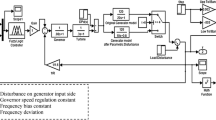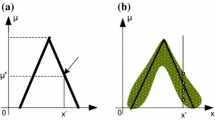Abstract
This paper presents a new method using Fuzzy Logic for generating lightning warnings. This methodology uses information about the atmospheric electric field, the lightning dynamics around the interest site, and lightning distance information. This information was combined by Fuzzy Logic which had its membership functions optimized by Genetic Algorithms. In addition, the objective function was composed by multiple performance indicators proposed in this work. The proposed methodology was tested in a case study, generating lightning warning for an oil refinery. The results were compared with other methods and it was concluded that this new method shows up to be the most effective in generating lightning warnings.


















Similar content being viewed by others
References
Araújo, F. M. U., Fonseca, C. A. G., Maitelli, A. L., & Medeiros, A. V. (2003). Algorítmos genéticos para otimização de um controlador nebuloso para supressão de vibrações. Bauru, Brazil (in Portuguese): VI Simpósio Brasileiro de Automação Inteligente.
Arslan, A., & Kaya, M. (2001). Determination of fuzzy logic relevance functions using genetic algorithms. Fuzzy Sets and Systems, 118(2), 297–306.
Beasley, W. H., Megan, M. L., Leon, G. B., Edward, R. M., Jabrzemski, R., Conway, J. W., & Eillts, M. D. (2005). On the need for electric field meters to support critical lightning hazard warning decision processes. Conference on meteorological applications of lightning data.
Cardoso, I. (2011). Os Números de Mortes por Raios no Brasil. Scientific American, Brasil, pp 42–45, July (in Portuguese).
Dudhia, J., Gill, D., Guo, Y. R., Manning, K., Bourgeois, A., Wang, W., Bruyere, C., Wilson, J., & Kelly, S. (2002). PSU/NCAR Mesoscale Modeling System. MM5 Modeling System Version 3. NCAR Technical Notes.
Frankel, D., Shiller, I., Draper, J. S., & Barnes, A. A., Jr. (1991). Use of neural network to predict lightning at Kennedy Space Center. Seattle international joint conference.
Frisbie, P. R., Colton, J. D., Pringle, J. R., Daniels, J. A., Ramey, J. D., Jr., & Meyers, M. P. (2009). Lightning prediction by WFO grand junction using model data and graphical forecast editor smart tools. Conference on the meteorological applications of lightning data.
Goldberg, D. E. (1989). Genetic algorithms in search, optimization, and machine learning. Boston, MA: Addison-Wesley.
Golde, R. H. (1997). Lightning, physics of lightning. (Vol. 1). New York: Academic Press.
Igarashi, A. Y. S., Leando, G. V., & Leite, E. A. (2011). Alerta de incidências de descargas atmosféricas utilizando lógica fuzzy. 10th Brazilian congress on computational intelligence, Fortaleza, Brazil.
Igarashi, A. Y. S., Leite, E. A. & Tesson, P. (2009). Analyse de la corrélation entre les données de champs électriques et la probabilité d’occurrence de décharges atmosphériques, PFE-IPB-Enseirb-Matmeca, Bordeaux, France (in French).
INPE [on-line] http://www.inpe.br/webelat/homepage/, Access October. 11th, 2012.
Karr, C. L. (1991). Design of an adaptative fuzzy controller using a genetic algorithm. 4th international conference on genetic algorithms.
Lacerda, M., Jaques, R., Rodriguez, C. A. M., Anselmo, E. M., Fritzen, C. L., Paro, J. C., Fernandes, W. A. & Dias, W. M. (2010). Estrutura elétrica de uma tempestade sobre a cidade de São Paulo, XVI Congresso Brasileiro de Meteorologia (in Portuguese).
Malan, D. J. (1963). Physics of lightning. London: Universities Press Ltd.
Mamdani, E. H., & Assilian, S. (1975). An experiment in linguistic synthesis with a fuzzy logic controller. International Journal of Man-Machine Studies, 7(1).
Meredith, D. L., Karr, C. L., & Kumar, K. K. (1992). The use of genetic algorithms in the design of fuzzy logic controllers. 3rd Workshop on Neural Network WNN’92.
Mission instruments. (2012). Electric field mill operation. http://www.missioninstruments.com.
Montanya, J., Bergas, J., & Hermoso, B. (2004). Electrical field measurements at ground level as a basis for lightning hazard warning. Journal of Electrostatics, 60, 241–246.
Murphy, M. J., Holle, R. L., & Demetriades, N. W. S. (2008). Cloud-to-ground lightning warnings using electric field mill and lightning observations. In 20th international lightning detection conference. Arizona, USA: Tucson.
Nagae, Y., Okumura, K, Suzuki, T., Kawamura, T., Miyake, Y. & Takahashi, S. (2000). Prediction of lightning activities by using fuzzy-neural network. International conference on lightning protection (ICLP), Rhodes, Greece, pp. 155–160.
Pedrycz, W., & Gomide, F. (1988). An introduction to fuzzy sets: Analysis and design. Cambridge, MA: The MIT Press.
Pinto, O. Jr. (2005). A Arte da Guerra Contra os Raios. Oficina de Textos Ed. São Paulo, Brazil. (in Portuguese).
RINDAT [on-line] http://www.rindat.com.br/ Access July 25th, 2012.
Simões, M. G., & Shaw, I. S. (2007) Controle e Modelagem Fuzzy (2nd Ed.). Blucher Ed. (in Portuguese).
Takagi, T., & Sugeno, M. (1983). Derivation of fuzzy control rules from human operator’s control actions. In IFAC symposium on fuzzy information, knowledge representation and, decision analysis (pp. 55–60). Marseille, France.
Tsukamoto, Y. (1979). An approach to fuzzy reasoning method. In M. M. Gupta, R. K. Ragade, & R. Yager (Eds.), Advances in fuzzy set theory and applications (pp. 137–149). Amsterdam: North-Holland.
Zepka, G. S. (2005). Estudo para o desenvolvimento de um previsor de descargas elétricas atmosféricas aplicado à região costeira do estado do Rio de Janeiro. Msc Thesis, Fundação da Universidade Federal do Rio Grande, Brazil (in Portuguese).
Zepka, G. S. (2011). Previsão de descargas atmosféricas usando o modelo de mesoescala WRF. Phd Thesis, Pós-Graduação em Geofísica Espacial/Ciências, Atmosféricas, INPE, São José dos Campos, Brazil (in Portuguese).
Acknowledgments
This work was supported by the Technological Institute SIMEPAR, through which the necessary financing to carry out activities relating to this paper was obtained. Moreover, due to SIMEPAR the assignment of the data used in this paper was possible, and due to CNPq and SETI/Araucaria Foundation the granting of scholarships to developing study as well new technologies concerned in this work was possible. The third author acknowledges the support of CNPq and Araucaria Foundation.
Author information
Authors and Affiliations
Corresponding author
Rights and permissions
About this article
Cite this article
Igarashi, A.Y.S., Leandro, G.V., Oliveira, G.H.C. et al. Genetic Algorithms Optimized Fuzzy Logic Control to Support the Generation of Lightning Warnings. J Control Autom Electr Syst 25, 32–45 (2014). https://doi.org/10.1007/s40313-013-0090-6
Received:
Revised:
Accepted:
Published:
Issue Date:
DOI: https://doi.org/10.1007/s40313-013-0090-6




